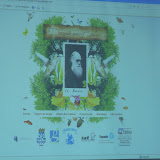Saturday, April 16, 2011
Thursday, March 17, 2011
BBC Audio Slideshow on Highgate Cemetery
Saturday, September 18, 2010
New photos of the British Cemetery by Pedro Muniz
Tuesday, July 07, 2009
Facing the Blue
By Tatiana Mendonça
Translated by H. Sabrina Gledhill
The expression goes “for the English to see.”* In this case, their dead have one of the best views of the bay. The fact that they can’t enjoy it is a mere detail. But anyone can share the peace and quiet that reigns supreme in the
But it hasn’t always been this way. There was a time when the jungle had taken over this place and thieves jumped over the fragile wall to hide their loot. It was back then, in 2004, that Sabrina Gledhill, a British researcher, came across the cemetery. She was working in the chapel with children from the Ibeji NGO. The social project is no more, but her interest in this place persisted.
Sabrina took part in the development of a revitalization project that gained the support of FazCultura (the state tax incentive program for cultural projects) and the Clemente Mariani Foundation. And then there was light. In February of last year, the cemetery founded in 1811 was reopened in the presence of the British Ambassador in
The
DOCTORS AND SLAVE TRADERS
The cemetery is located in one of the finest parts of the city and is the resting place of some 500 people. “It is hard to say exactly how many, because many of the tombstones have disappeared,” says Sabrina. The records show that two sailors from the Beagle, which brought
One of the tombs that is still in its original place is that of John Ligertwood Paterson, MD. A pioneer in the fight against cholera and yellow fever, he helped found the
The first person buried in this place was John Sharp, a slave trader who died in 1813. His tomb lies in the shadow of a tree, the stone covered in moss.
But it isn’t just Britons who are buried here. A Bahian woman, Maria Constância Ogilvie, the wife of a British merchant, is also there. After she died, her husband returned to
The
*(Translator’s note: A Brazilian expression meaning “whitewash” or “sham” – the author is using it literally in this case.)
Article published in Muito magazine by the A Tarde newspaper on 5th July 2009
Tuesday, February 24, 2009
Darwin in Bahia programme launch
 |
| Darwin Launch/Lançamento |







